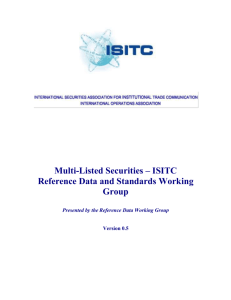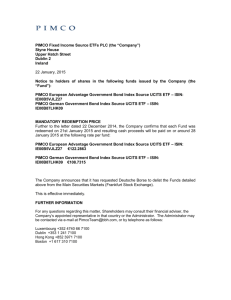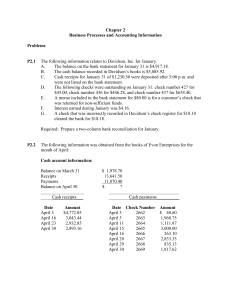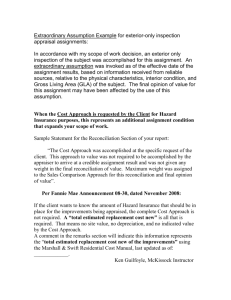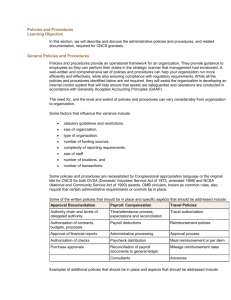- ISO 20022
advertisement
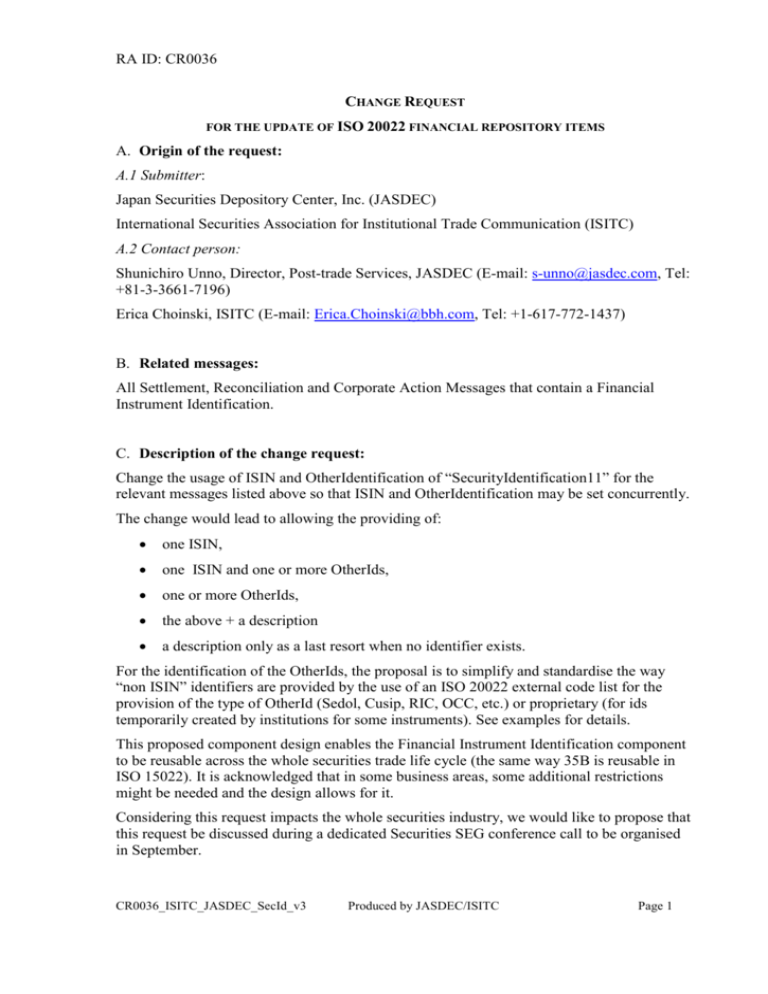
RA ID: CR0036 CHANGE REQUEST FOR THE UPDATE OF ISO 20022 FINANCIAL REPOSITORY ITEMS A. Origin of the request: A.1 Submitter: Japan Securities Depository Center, Inc. (JASDEC) International Securities Association for Institutional Trade Communication (ISITC) A.2 Contact person: Shunichiro Unno, Director, Post-trade Services, JASDEC (E-mail: s-unno@jasdec.com, Tel: +81-3-3661-7196) Erica Choinski, ISITC (E-mail: Erica.Choinski@bbh.com, Tel: +1-617-772-1437) B. Related messages: All Settlement, Reconciliation and Corporate Action Messages that contain a Financial Instrument Identification. C. Description of the change request: Change the usage of ISIN and OtherIdentification of “SecurityIdentification11” for the relevant messages listed above so that ISIN and OtherIdentification may be set concurrently. The change would lead to allowing the providing of: one ISIN, one ISIN and one or more OtherIds, one or more OtherIds, the above + a description a description only as a last resort when no identifier exists. For the identification of the OtherIds, the proposal is to simplify and standardise the way “non ISIN” identifiers are provided by the use of an ISO 20022 external code list for the provision of the type of OtherId (Sedol, Cusip, RIC, OCC, etc.) or proprietary (for ids temporarily created by institutions for some instruments). See examples for details. This proposed component design enables the Financial Instrument Identification component to be reusable across the whole securities trade life cycle (the same way 35B is reusable in ISO 15022). It is acknowledged that in some business areas, some additional restrictions might be needed and the design allows for it. Considering this request impacts the whole securities industry, we would like to propose that this request be discussed during a dedicated Securities SEG conference call to be organised in September. CR0036_ISITC_JASDEC_SecId_v3 Produced by JASDEC/ISITC Page 1 RA ID: CR0036 D. Purpose of the change: In the US Market, the ISITC Reconciliation working group is requesting multiple security identifier functionality within reconciliation messages. While the working group supports the use of ISIN, there are scenarios where more than one identifier would increase automation of reconciliation processes as noted in the business justification section. There is no risk in having additional security Identifiers where ISIN is recommended and additional security identifiers where local ID could be used as needed simultaneously. The US Market currently utilizes the functionality today in that firms choose any security identifier or multiple IDs as bilaterally agreed upon between messaging partners. Typically the hierarchy is defined between two parties. If the concern is risk, market practice has defined ISIN as the recommendation and the sender of the message is responsible for sending the appropriate security identifier in the messages. After additional analysis, ISITC Settlements and Corporate Actions have identified business cases where having the ability to provide more than one security identifier is beneficial within specific business processes noted below. ISITC believes that it is in the best interest from a standards perspective to harmonize the security identifier structure throughout the trade lifecycle, from pre-trade/trade, settlements, reconciliation, corporate actions, and all messages with security identifier in use. Further, ISITC would like to amend the use of primary identifier to be optional as the ability to provide other identifiers is adequate and consistent with how we currently utilize the securities messages in the US. In Japan, JASDEC provides the central matching service (Pre-Settlement Matching System: PSMS) and PSMS permits its users to use either ISIN or the local code for financial instruments identification when they send the messages to PSMS. PSMS does cross matching of the financial instruments identification and it enriches missing financial instrument identification code when it sends out allegement and matching status to the counterparty/both parties or redirects a settlement instruction to a third party as a copy, etc. Also, JASDEC’s book-entry transfer system (BETS) for stocks permits its users to use either ISIN or the local code when they send the messages to BETS. BETS uses the local code for internal processing and enriches ISIN when it sends out settlement confirmation, etc. to the settlement parties. Thus JASDEC needs to set both ISIN and local code concurrently in one message. E. Urgency of the request: The request should be reflected by SR 2011. F. Business examples: ISITC Case 1: In some reconciliation reporting, there is no industry financial instrument identifier available. In these cases the Asset Manager sends a proprietary ID. In some cases the Identifier may become available or assigned following settlement. In which case, it is helpful to provide both the proprietary ID and the newly issued identifier to allow for STP in reconciliation. CR0036_ISITC_JASDEC_SecId_v3 Produced by JASDEC/ISITC Page 2 RA ID: CR0036 ISITC Case 2: In the US, several organizations offer reconciliation processing as a product. In this service model, there is no visibility to the trade instructions, the source of the data, or linking to a security master database. The firm providing the reconciliation service receives in Custodian/Accounting Agent reconciliation statement messages and the corresponding Asset Servicers reconciliation messages to produce an exception report. It is beneficial in this service model to have the ability to receive more than one identifier to increase the ability to match positions and reduce the exceptions on the report. Again, the senders of the messages would be responsible for the data within the messages. Business Diagram: $ Trade Settlements Security Master $ Trade Settlements $ Security Master Custodian/Accounting Agent 1 Asset Servicer Reconciliation Statements Reconciliation Statements Security Master Custodian/Accounting Agent 2 Reconciliation Statements Reconciliation Service Provider Reconciliation Utility Reconciliation Exception Report ISITC Case 3: The ISITC Reconciliation working group supports adding more than one identifier as there are currently Service Level Agreements between organizations to support sending multiple security identifiers. As a result, messaging standards should accommodate a business processing request that has already been contractually agreed upon. To avert utilizing free format fields, a structured field is preferred by the US. Example of format used today between messaging partners: Tag 35B: :35B:ISIN GB00B127GF29 /GB/B127GF2/US/CB127GF26 CORUS GROUP PLC ORD GBP0.5 ISITC Case 4: The ISITC Settlements working group has identified a few short term instruments that do not always have standard identifiers at the time they are traded. Some examples include: Certificates of Deposit, Commercial Papers, and Money Market accounts. This also applies CR0036_ISITC_JASDEC_SecId_v3 Produced by JASDEC/ISITC Page 3 RA ID: CR0036 to some TBAs as well. In these scenarios the Investment Manager has sent a dummy security identifier for a holding since there was no market identifier available. When the security identifier is assigned, the next time Investment Manager is buying or selling the same security, the Investment Manger will need to communicate to the Custodian both identifiers to allow the Custodian to link the security identifiers together on the new buy or sell transaction. Custodian would report back on reconciliation statement the new market security identifier and their previously used dummy identifier to report the entire holding for the instrument. ISITC Case 5: ISITC has also determined that the ability to provide multiple security identifiers is applicable in Corporate Actions for rights where the initial announcement may utilize a dummy security identifier and an ISIN is issued following the notification of the event. In this case having the ability to provide both security identifiers will link the dummy identifier to the market identifier when one is available. JASDEC Case 1: Multiple Systems at participant level There are multiple systems at participant level, and each of them uses different identifiers. A local code is often an identification key in front systems such as OMS (Order Management System), trading system, etc. On the other hand, ISIN code is an identification key in backoffice systems such as customer reporting system, settlement system, etc. Therefore, PSMS and BETS provide 2 kinds of identifications so that each participant can establish connections among its multiple systems easily. In the case of PSMS, this post-trade matching system communicates with the front office trading system (local code) and backoffice settlement systems (ISIN) of the same client and it is important that both identifiers are provided in the reporting. CR0036_ISITC_JASDEC_SecId_v3 Produced by JASDEC/ISITC Page 4 RA ID: CR0036 Order Investment Manager NOE Allocation Inv est m Tra ent I de nst Sta ruct tus ion Re po rt ion/ truct s n I st Inve port e Re Trad PSMS Trade Matching ort Rep e d rt Tra epo us R t a t eS Trad Notice of TR Affirming Status Trading System Reconciliation between the trading result and the settlement processing status Notice of TR Approval Affirming Status Broker / Dealer SSI Trust Bank Settlement Status Report Settlement Confirmation Settlement Matching BETS Settlement Status Report Back office System Settlement Confirmation For example, one broker administers the result of trading (including the instruction to PSMS and trade status reporting back) in its trading system and the transmission of the settlement matching status and settlement confirmation status in its back-office system. (See above) When the status messages or the confirmation messages are received from PSMS or BETS, an ISIN code is used as identification key and the above mentioned status are updated in its back-office system. Besides, a local code is captured as one of financial attributes in its backoffice system at this moment. When these data in its back-office system are transmitted to its trading system, a local code is used as an identification key in its trading system for reconciliation between the trading result and progress in PSMS and BETS. JASDEC Case 2: Preference of participant’s customer As each customer of the participant prefers different identifications in its reports, it is necessary for some participants to use the preferred identification for each of their account. Therefore, PSMS provides, as a service to its customers, 2 kinds of identifications so that each participant can establish, using data coming directly from the market, its reporting system based on customer’s preference. In this case, it is insufficient to specify the preference identification per each participant in PSMS. (See below.) CR0036_ISITC_JASDEC_SecId_v3 Produced by JASDEC/ISITC Page 5 RA ID: CR0036 Broker / Dealer, Custodian PSMS Settlement Status Report Settlement Status Report With A Local Code Customer A Back office System Settlement Status Report With An ISIN Code Customer B Examples (for illustration purposes) CR0036_ISITC_JASDEC_SecId_v3 Produced by JASDEC/ISITC Page 6 RA ID: CR0036 Example 1. (ISIN + Local ID + Description) <FinInstrmId> <ISIN>JP3435000009</ISIN> ISIN <OthrId> <Id>67580</Id> ID code <Tp> <Cd>SICC</Cd> ISO 20022 External Code (SICC) </Tp> </OthrId> <Desc>SONY CORPORATION</Desc> Description </FinInstrmId> Example 2 (ISIN + Local ID + Description) <FinInstrmId> <ISIN>GB00B127GF29</ISIN> <OthrId> <Id>CB127GF26</Id> <Tp> <Cd>CUSP</Cd> ISO 20022 External Code (CUSIP) </Tp> </OthrId> <Desc>CORUS GROUP PLC ORD GBP0.5</Desc> </FinInstrmId> Example 3 (Two other IDs + Description) <FinInstrmId> <OthrId> <Id>CB127GF26</Id> <Tp> <Cd>CUSP</Cd> ISO 20022 External Code (CUSIP) </Tp> </OthrId> CR0036_ISITC_JASDEC_SecId_v3 Produced by JASDEC/ISITC Page 7 RA ID: CR0036 <OthrId> <Id>B127GF2</Id> <Tp> <Cd>SEDO</Cd> ISO 20022 External Code (SEDOL) </Tp> </OthrId> <Desc>CORUS GROUP PLC ORD GBP0.5</Desc> </FinInstrmId> Example 4 (Proprietary dummy ID + Description) <FinInstrmId> <OthrId> <Id>ABCDEF123</Id> <Tp> <Prtry>CUST</Prtry> Type of ID (dummy custodian ID) </Tp> </OthrId> <Desc>COMMERCIAL PAPER ABCD</Desc> </FinInstrmId> Example 5 (ISIN + Description) <FinInstrmId> <ISIN>FR0000133308</ISIN> <Desc>FRANCE TELECOM</Desc> </FinInstrmId> Example 6 (Two proprietary dummy IDs + Description) <FinInstrmId> <OthrId> <Id>XYZ09876</Id> <Tp> <Prtry>CUSTDUMC</Prtry> CR0036_ISITC_JASDEC_SecId_v3 Type of ID (dummy cusip custodian) Produced by JASDEC/ISITC Page 8 RA ID: CR0036 </Tp> </OthrId> <OthrId> <Id>ABCDEF123</Id> <Tp> <Prtry>IMMIDUMS</Prtry> Type of ID (dummy sedol IM) </Tp> </OthrId> <Desc>COMMERCIAL PAPER ABCD</Desc> </FinInstrmId> CR0036_ISITC_JASDEC_SecId_v3 Produced by JASDEC/ISITC Page 9 RA ID: CR0036 G. SEG recommendation: This section is not to be taken care of by the submitter of the change request. It will be completed in due time by the SEG(s) in charge of the related ISO 20022 messages. Consider Y Timing - Next yearly cycle: 2010/2011 (the change will be considered for implementation in the yearly maintenance cycle which starts in 2010 and completes with the publication of new message versions in the spring of 2011) - At the occasion of the next maintenance of the Y messages (the change will be considered for implementation, but does not justify maintenance of the messages in its own right – will be pending until more critical change requests are received for the messages) - Urgent unscheduled (the change justifies an urgent implementation outside of the normal yearly cycle) Priority: high medium low - Other timing: Comments: Approve, to be implemented at message set level organically, but at latest within 3 years. To be in line with other sectors, should be considered for implementation in Investment Funds messages in 2016/2017 maintenance cycle. Reject Reason for rejection: CR0036_ISITC_JASDEC_SecId_v3 Produced by JASDEC/ISITC Page 10
